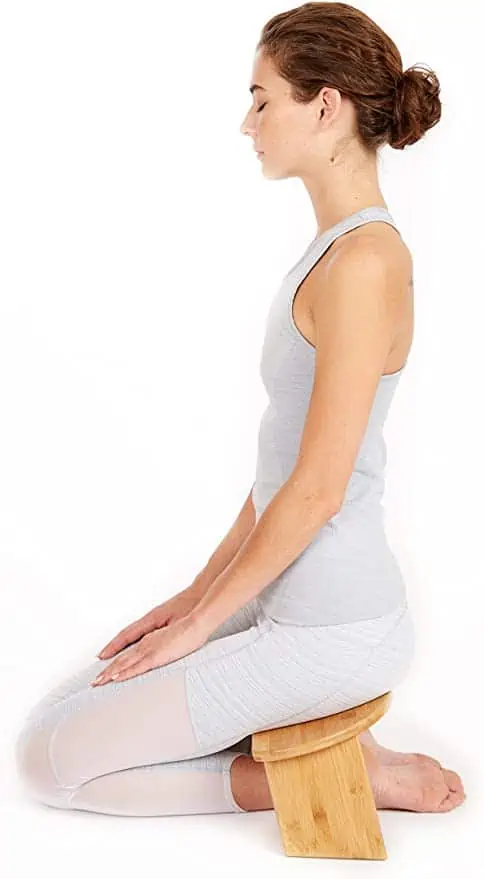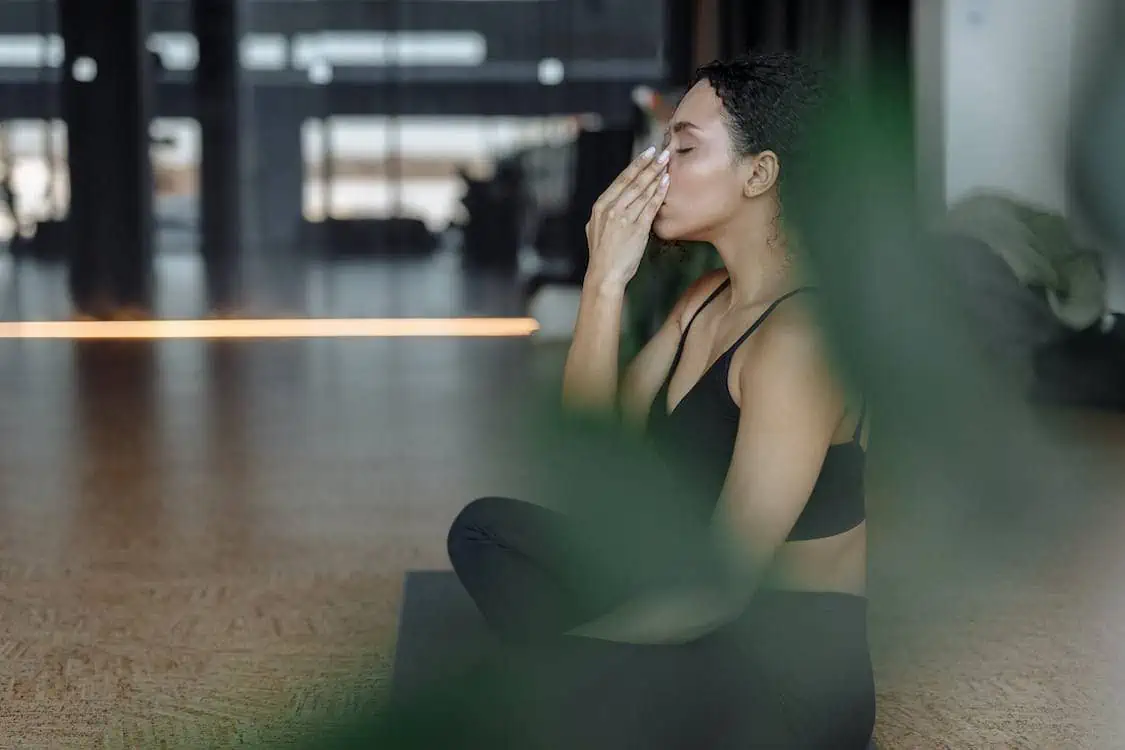When you’re feeling anxious or stressed, people often say “just take a deep breath.” But there is a lot more to breathing than the classic sigh. In yoga, breathing exercises are also known as pranayama.
In Sanskrit, “prana” means life force or energy and “yama” means control. Pranayama techniques encompass many forms of deep yogic breathing exercises to calm the body and relax the mind. Interestingly, there are also certain types of breath control that can give you more energy.
Here are the top 4 yoga breathing techniques for reducing stress and increasing energy + how to practice them.
Contents
How Should I Breathe During Yoga?
Standard yoga breathing (pranayama) focuses on deep belly breathing through the nose. During standard poses (asanas), you should take slow, deliberate breaths where the inhales and exhales are the same length. If they don’t match up with the teacher’s guides, simply try to move your body to your own breath.
Yoga breathing starts with a slow inhale through the nose. You should send air to fill the diaphragm rather than shallowly breathing in the chest. Then comes a gradual exhale as you tighten your belly and blow air out of your nose for the same duration as the inhale. In general:
- Inhalation length should match the exhalation length. For example, if you inhale on a count of 3, you should exhale on a count of 3.
- Inhales are used to lengthen and extend parts of your body. You often inhale on an upward motion.
- Exhales are used to flex muscles, deepen a twist, or contract body parts. You usually exhale during a downward motion.
For example, in a Vinyasa yoga you use inhalations and exhalations to “flow” through different poses. If you are doing Mountain Pose (Tadasana), you typically inhale as you bring your arms up by the sides of your head, then exhale as you hinge forward into a Forward Fold (Uttanasana). You may hold the pose for 2 to 3 rounds of breath and then inhale to stand back up.
Benefits of Pranayama Breathing
Yoga is so much more than simply contorting your body into an awkward position. It is about merging breath work (pranayama) and movement (asana) to calm your mind and body. In fact, the Sanskrit word yoga means “to yolk” or “unite”. When you do yoga, you are consciously uniting deep breaths with intentional motion.
Pranayama breathing techniques are also used in meditation and mantra to
The benefits of pranayama breathing have been proven in a range of scientific studies:
- Reduced stress
- Reduced anxiety
- Improved mood and vitality
- Reduced fatigue (more energy and alertness)
- Healing from depression
- Improved pulmonary (lung) function
- Better cardiovascular health
- Reduced symptoms of asthma
- Improved health of cancer patients
- Reduced insomnia (better sleep quality and quantity)
- Alleviation of menopausal symptoms
Needless to say, this ancient system of deep breathing and breath retention has some profound effects on the human brain and nervous system. Here’s how to harness these benefits along with your daily yoga or meditation practice:
How to Fix Back Pain During Meditation and Breathing Exercises
Some pranayama techniques can be used during your asana practice while others are best done in a seated or laying position. Our favorite way to practice pranayama is on a meditation bench that reduces back pain so we can focus on airflow. The Green Eos folding bench is extra comfortable thanks to its bamboo construction and ergonomic design to reduce pain and pressure in the spine.

Top 4 Yoga Breathing Techniques
Ocean Breath or Victorious Breath (Ujjayi Breath)
This breath regulating technique creates a soft, whispering breath through the strategic throat contraction. It can sound like wind through the trees or waves lapping onto the shore.
Benefits: The steadiness of this breath anchors you in the present moment and helps you flow through asanas. It improves the oxygenation of your blood and helps build internal heat.
How to Do It: Start in a seated position with your spine straight. Slowly take a deep inhalation through your nose and slightly narrow the back of your throat so you can hear the breath flowing in.
Your throat shouldn’t feel overly tight nor should it be completely relaxed like it is during normal breathing. Finish a breath cycle by slowly exhaling through the nose and maintaining the same throat contraction. This slight closing at the back of the airways allows you to inhale longer and slower. Try to make your breath sound like the ocean waves. Maintain inhales and exhales that are the same length.
Precautions: Avoid practicing Ujjayi if you have heart disease, high blood pressure, or another cardiovascular disease. Avoid tightening your throat or straining your breath. You should not feel as if you are gasping for air. It is also best to do Ujjayi Pranayama on an empty stomach.
Watch this video to learn how:
Lion’s Breath or Breath of Fire (Simhasana Pranayama)
If you need a morning energy boost before yoga practice or an “afternoon pick-me-up”, you’d be surprised by how much this forceful breathing technique can improve your energy levels. While you may look a little goofy as you try to embody the strength of a lion, this practice can drastically invigorate your mind without any caffeine.
Benefits: Boost energy, clear the throat chakra, clear emotions, and strengthen your lungs.
How to Do It: Start in a kneeling or cross-legged position and optionally bring your hands to your knees. Spread the fingertips wide and lean forward slightly as you activate your arm muscles.
Slowly inhale through your nose. On the exhale, open your mouth as wide as you can and stick out your tongue while you force air out of your lungs. The air should make a “ha” sound as it passes over your entire tongue. Don’t be afraid to get loud- Breath of fire is meant to build energy, heat, and vocal expression. Don’t worry about what you look like! Everyone looks goofy doing this breath work.
Relax your face and breath normally for a few breaths before starting again. Remember to forcefully expel the breath on the exhale as you engage your diaphragm and stick out your tongue. Some yogis also widen their eyes to add to the awakening energy.
Repeat for 4-6 rounds of breath and then breathe deeply for a few minutes before returning to normal breath.
Precautions: Avoid practicing Lion’s Breathing if you have respiratory or cardiovascular problems. This technique is not as beginner-friendly and can make you feel faint if you repeat it too many times.
Watch this video to learn more about Lion’s Breath:
Breath Retention (Kumbhaka Pranayama)
When you are about to start a yoga class or an intense project that requires your focus, this deep breathing sends extra oxygen flow to the brain and helps you be more alert. Therapists even use this technique to help people who are having panic attacks. It’s similar to “box breathing”.
Benefits: Calming effect, reduced stress, grounding energy, more oxygenated blood, and enhanced focus.
How to Do It: This yoga breathing exercise is best practiced laying flat on your back, but you can also do it in a cross-legged position. Laying on your mat gives you the advantage of feeling the air move through your body as you make contact with the earth.
Close your eyes and relax. Inhale through your nose and fill your stomach up with air as if its a balloon. Be sure the air goes down to your diaphragm instead of your chest. It can feel like you’re puffing out your stomach. Hold the air at the top and see if you can draw in a little bit more breath through your nose. Then deeply exhale slowly once again.
Then, begin exhaling through your nose as you draw your belly button toward your spine. Flex your abs and push every last bit of air out.
Repeat for 5 to 10 breaths. Find an even duration between the inhales, holds, and exhales.
Precautions: Avoid straning or holding the breath for too long at the top. Don’t force your lungs (they should feel full, but uncomfortable like they’ll burst from any more air).
Alternate Nostril Breathing (Nadi Shodhana Pranayama)
Alternate nostril breathing is the best pranayama practice for purifying your energy passages in the body and relaxing your nervous system. It can also be useful after recovering from a cold or using a neti pot to cleanse your sinuses. Alternate nostril breathing is best practiced after asana practice to prepare for meditation or sleep.
Benefits: Relaxed nervous system, soothe anxiety, release clogged sinuses, improved focus, and lowered blood pressure.
How to Do It: Start in a comfortable seated position. Make a gentle fist with your right hand and bring it in front of your nose. Uncurl the thumb and ring finger, then softly close you right nostril with your right thumb.
Inhale slowly through the left nostril, then hold the breath at the top and close the left nostril with your ring finger. Open your right nostril and slowly exhale. Then, inhale through the right, close it, and exhale slowly through the left nostril.
The flow of this breath should feel like an upside down “U” shape moving through your sinuses. Imagine holding the breath up by your third eye. The length of inhale, hold, and exhale should be the same. Repeat the cycle 3-10 times, or until you feel relaxed and cleansed. Keep your mouth closed.
Precautions: Avoid this practice when you have clogged nasal passages, as you might not be able to inhale enough air.
Watch this video to learn more:
Key Takeaways: Reduce Stress and Build Basic Breath Awareness with Yoga Breathing
Any type of deep breathing is good for the body, but yoga breathing was specifically designed to elevate your body into higher levels of consciousness and relaxation. Whether you’re feeling stressed out in the office or trying to quit your afternoon coffees, try out a pranayama technique to replenish your body’s oxygen levels.
Namaste!



